Are you interested in growing fresh and nutritious leafy green vegetables in the comfort of your home? Look no further! This step-by-step guide will explore the exciting world of hydroponics and learn how to cultivate leafy greens using this innovative method. Hydroponics allows you to grow plants without soil, making it a space-saving and efficient technique. Whether a beginner or an experienced gardener, this guide will provide clear and concise instructions to help you succeed in your hydroponic leafy green vegetable garden.
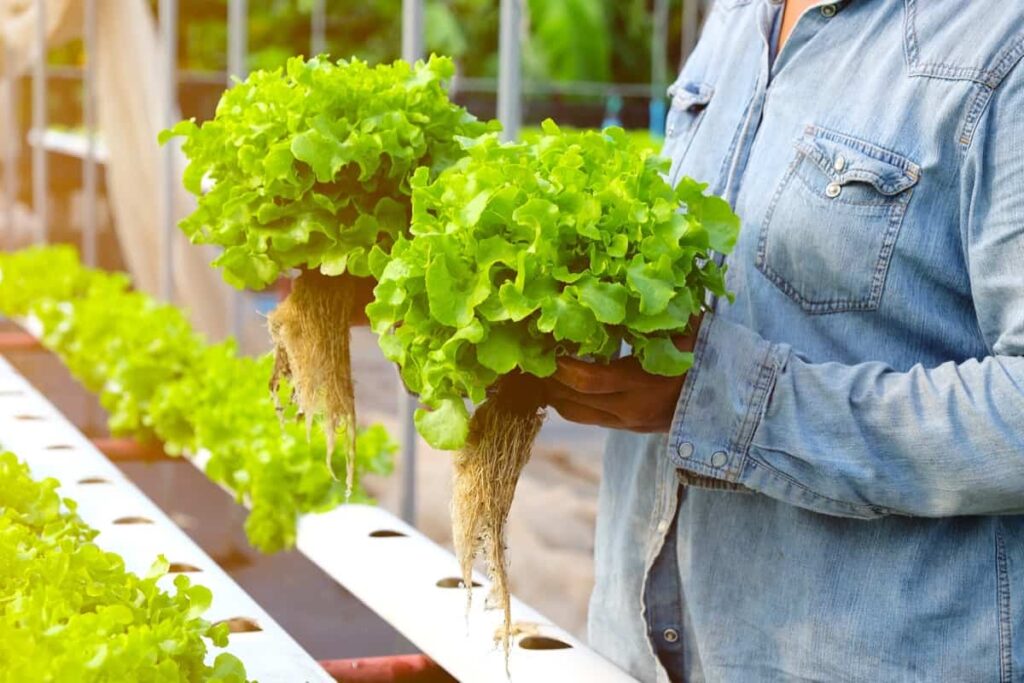
How to Grow Leafy Green Vegetables in Hydroponics
What is Leafy Green Vegetable Hydroponics?
Leafy green vegetable hydroponics is a method of growing greens like lettuce, spinach, and kale, without soil, using nutrient-rich water solutions. Scientific studies have shown that hydroponic systems can produce higher yields and faster growth than traditional soil-based methods. Hydroponic lettuce had a significantly higher fresh weight and leaf area than soil-grown lettuce. Furthermore, hydroponics allows for precise control of nutrient levels, pH, and environmental factors, resulting in healthier plants with reduced risk of pests and diseases.
Step-by-step Guide on Growing Leafy Green Vegetables in Hydroponics
- Choosing the right leafy green vegetables: Opt for varieties like lettuce, spinach, kale, and Swiss chard, as they thrive in hydroponic systems due to their shallow root systems and fast growth.
- Setting up the hydroponic system: Select a suitable system based on available space and resources, such as a nutrient film technique (NFT) or deep water culture (DWC). Ensure proper system installation, including reservoirs, pumps, and growing containers.
- Preparing the nutrient solution: Follow recommended nutrient formulations, providing essential macronutrients (nitrogen, phosphorus, and potassium) and micronutrients (iron, calcium, and magnesium). Maintain accurate nutrient concentrations for optimal plant growth and health.
- Germinating seeds or transplanting seedlings: Create a favorable environment with appropriate temperature and humidity levels for successful seed germination, or use pre-grown seedlings for convenience.
- Monitoring and maintaining the hydroponic environment: Monitor pH levels, electrical conductivity (EC), and water temperature to ensure optimal conditions. Adjust nutrient solution and environmental parameters as needed.
- Pruning and trimming leafy green vegetables: Promote airflow and prevent overcrowding by selectively removing older or damaged leaves. Encourage bushier growth by trimming the tips of plants.
- Harvesting and post-harvest care: Harvest leafy greens when they reach the desired size, using clean tools to avoid contamination. Store harvested greens in a cool, dark place or consume them immediately for maximum freshness and flavor.
In case you missed it: How to Grow Bok Choy Hydroponically: A Step-by-Step Guide for Planting to Harvesting
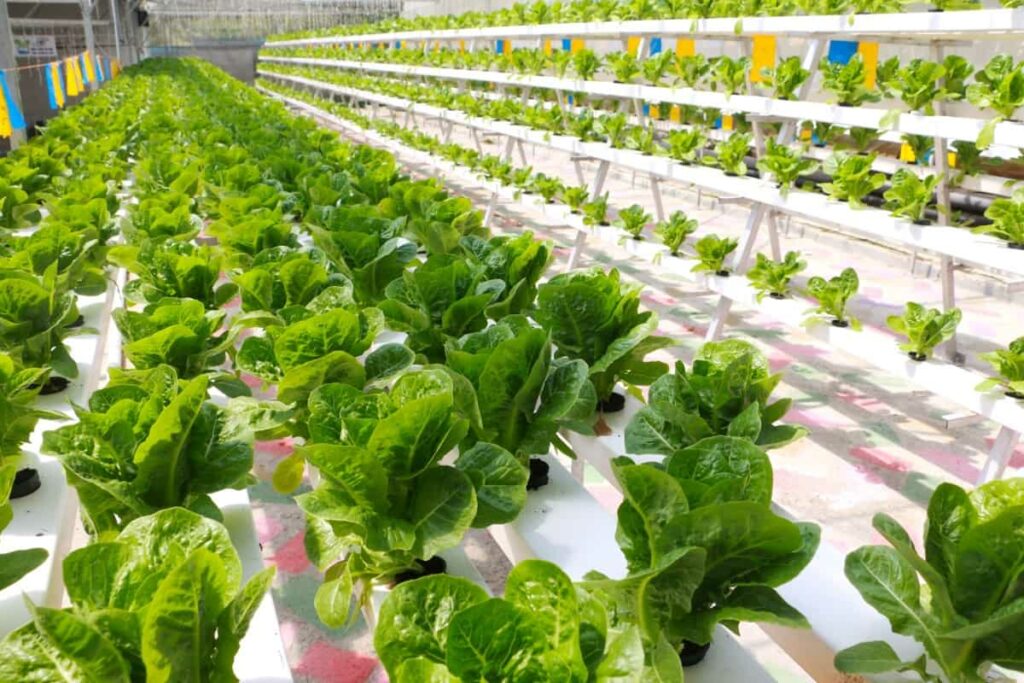
Growing Leafy Green Vegetables in Hydroponics
Growing leafy green vegetables in hydroponics offers a controlled environment for year-round production. Basics of hydroponic systems and production methods for leafy greens of lettuce, arugula, kale, mustard, spinach, and more.
Choose Your System: The two commonly used hydroponic systems for leafy greens are deep water culture (DWC) and nutrient film technique (NFT). DWC involves transplanting seedlings onto Styrofoam rafts that float on a nutrient solution-filled pond. NFT uses shallow channels with a thin film of nutrient solution continuously flowing.
Head Lettuce: Surface-sown seeds are germinated in trays with a substrate like rockwool for head lettuce production. Optimal temperature and light conditions are maintained during germination and seedling stages. Transplanting occurs when seedlings have three to four true leaves. Lettuce heads are grown in the hydroponic system, and proper temperature, light, and nutrient levels are crucial for successful growth.
Baby Leaf Greens: Various leafy greens, including lettuce, arugula, kale, and mustard, can be grown as baby leaf greens. The head lettuce production system can be adapted by sowing multiple seeds per cell and transplanting them to high-density spacing. Another method is using foam Speedling trays filled with a soilless mix. Germinated plants are then floated on the nutrient solution.
Optimal Growing Conditions: Maintaining appropriate temperature, humidity, dissolved oxygen levels, and nutrient solution composition is essential for successful hydroponic leafy green production. Providing adequate light through natural sunlight or supplemental lighting is critical for photosynthesis and plant growth.
Nutrient Management: A proper nutrient solution with balanced nitrogen concentrations and other essential elements is crucial for healthy plant growth. Monitoring pH levels and the nutrient solution’s electrical conductivity (EC) is necessary to ensure optimal nutrient uptake.
In case you missed it: Hydroponic Nutrient Chart: For Vegetables, Herbs, and Flowers
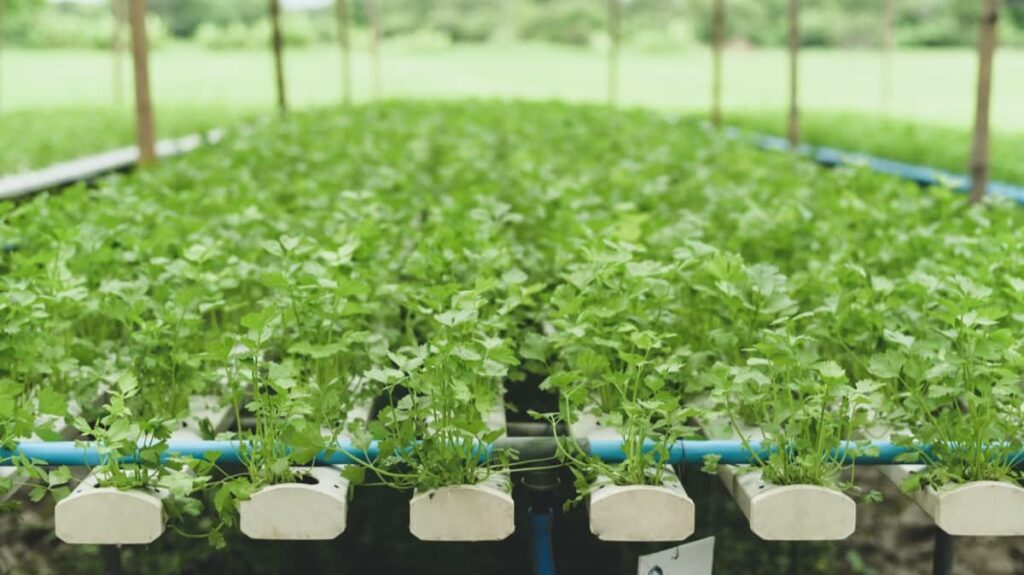
Best Nutrient Solutions for Hydroponic Leafy Green Vegetables
- Macronutrients: Leafy greens require a balanced supply of macronutrients, including nitrogen (N), phosphorus (P), and potassium (K). These nutrients support overall plant growth, leaf development, and chlorophyll production.
- Micronutrients: In addition to macronutrients, leafy green vegetables also benefit from essential micronutrients like iron (Fe), calcium (Ca), and magnesium (Mg). These micronutrients are vital in photosynthesis, enzyme activation, and overall plant health.
- Pre-formulated nutrient solutions: Many commercially available nutrient solutions are specifically formulated for hydroponic leafy greens. These solutions provide a precise blend of nutrients to meet the plants’ requirements at different growth stages.
- Custom nutrient formulations: Some growers prefer to create nutrient solutions by carefully adjusting the nutrient concentrations based on plant needs. This allows for more precise control over nutrient levels.
- pH balance: Maintaining the correct pH level is crucial for nutrient uptake by leafy green vegetables. Generally, a slightly acidic pH range between 5.5 and 6.5 is suitable for optimal nutrient absorption.
- Nutrient solution management: Regularly monitoring nutrient levels, pH, and electrical conductivity (EC) is essential to ensure the solution remains balanced and within the desired range.
Optimal pH Levels for Leafy Green Vegetables in Hydroponics
Scientific data indicates that most leafy greens thrive within a pH of 5.5 to 6.5. This pH range ensures optimal nutrient availability to the plants, promoting healthy development. However, different leafy greens may exhibit slight variations in their preferred pH levels. For instance, lettuce generally prefers a slightly lower pH of 5.5 to 6.0. Monitoring and maintaining the pH within the recommended range is essential for maximizing nutrient absorption and preventing nutrient deficiencies or toxicities, ultimately leading to the successful hydroponic cultivation of leafy green vegetables.
Optimum Conditions for Growing Hydroponic Leafy Greens
- Germination: During the first 24 hours, a temperature of 68°F is maintained, along with a minimum light intensity of 50 µmol·m-2·s-1 or a daily light integral (DLI) of 4 mol·m-2·d-1. This ensures seedling growth without stretching and prevents drying of the medium’s surface.
- Seedling stage: Greenhouse day/night temperatures of 75/66°F are maintained, with a high DLI of 22 mol·m-2·d-1 using a combination of sunlight and supplemental lighting. Seedlings are transplanted into the hydroponic system when they have three to four true leaves.
- Growing stage: Temperatures of 75/66°F are maintained with a relative humidity of 50-70%. Dissolved oxygen (DO) concentration of around 7-8 ppm in the nutrient solution is essential for preventing crop failure.
- Lighting: Optimal light levels are crucial for shorter crop cycles and higher yields. A DLI of 17 mol·m-2·d-1 allows 5-6 ounce heads of lettuce to be harvested 24 days after transplanting. Proper airflow, such as vertical airflow fans, helps prevent tip burn, a disorder caused by inadequate calcium supply.
- Fertilizer: Sonneveld’s hydroponic lettuce recipe is commonly used, with a nutrient solution concentration of 150 ppm nitrogen. The pH is between 5.5 and 6.0, and the fertilizer electrical conductivity (EC) is approximately 1.5 mhos/cm2.
- Baby leaf greens: Hydroponic systems can also be used for baby leaf production, including crops like arugula, kale, mizuna, and mustard. Multiple seeds per cell can be sown, and high-density spacing is recommended.
In case you missed it: Hydroponic Farming Cost and Profit in India: Cultivation and Production Management
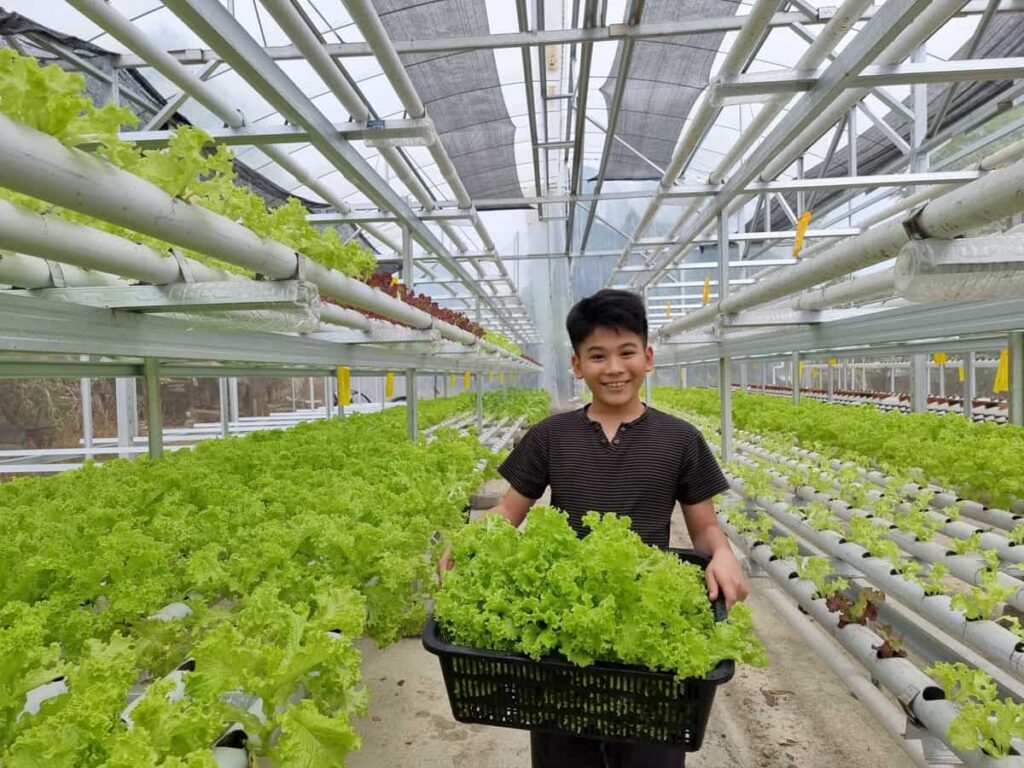
Effective Lighting Techniques for Hydroponic Leafy Green Vegetables
- Light intensity: Leafy greens thrive under a minimum light intensity of 200-400 µmol·m-2·s-1, which can be achieved using high-quality LED grow lights.
- Light spectrum: A balanced spectrum with a higher proportion of blue (400-500 nm) and red (600-700 nm) wavelengths promotes photosynthesis and overall plant development.
- Photoperiod: Providing 14-16 hours of light daily ensures sufficient energy for leafy green growth and minimizes stretching.
- Light distribution: Evenly distributing light throughout the growing area using reflective surfaces or multiple light sources ensures uniform plant growth.
- Light duration: Leafy greens typically require 12-16 hours of continuous light exposure daily to optimize photosynthesis and growth.
Common Challenges and Solutions in Hydroponic Leafy Green Vegetable Cultivation
When cultivating hydroponic leafy green vegetables, several common challenges can arise. These challenges include system leaks, inadequate lighting, incorrect fertilizer usage, lack of cleanliness, insufficient monitoring of plant health, pH level neglect, nutrient deficiency or toxicity, hard water issues, inadequate monitoring of nutrient concentration, pump and nozzle problems, improper choice of growing medium, periodic flushing and refilling of the system, and inconvenient system design.
To overcome, it is important to test the system for leaks, tighten connections, and regularly check for clogs or overflows. Investing in quality LED or T5 fluorescent grow lights with the correct wavelengths is essential. Using hydroponics-specific nutrients or creating a customizable solution is recommended.
Regularly cleaning the system, drains, media, and reservoir is crucial. Continuously learning from experiences, monitoring plant health, and addressing issues promptly is necessary. Monitoring and adjusting the pH level with an electric pH meter is vital. Diluting hard water or using filters can help prevent problems.
Monitoring nutrient solution concentration with an EC PPM TDS meter and adjusting as needed is important. Regular system checks and designing for failure prevention are advised. Choosing a suitable growing medium based on various factors and personal preferences is key. Flushing the system and changing the nutrient solution regularly is crucial. Lastly, starting small and considering convenience in system design are recommended practices.
Choosing the Right Hydroponic System for Growing Leafy Green Vegetables
Choosing the right hydroponic system for growing leafy green vegetables, such as lettuce, arugula, kale, mustard, and spinach, is crucial for successful and year-round local production. The two most common systems are deep water culture (DWC) and nutrient film technique (NFT).
In case you missed it: 20 Key Rules for Setting Up a Budget Hydroponic Garden at Home
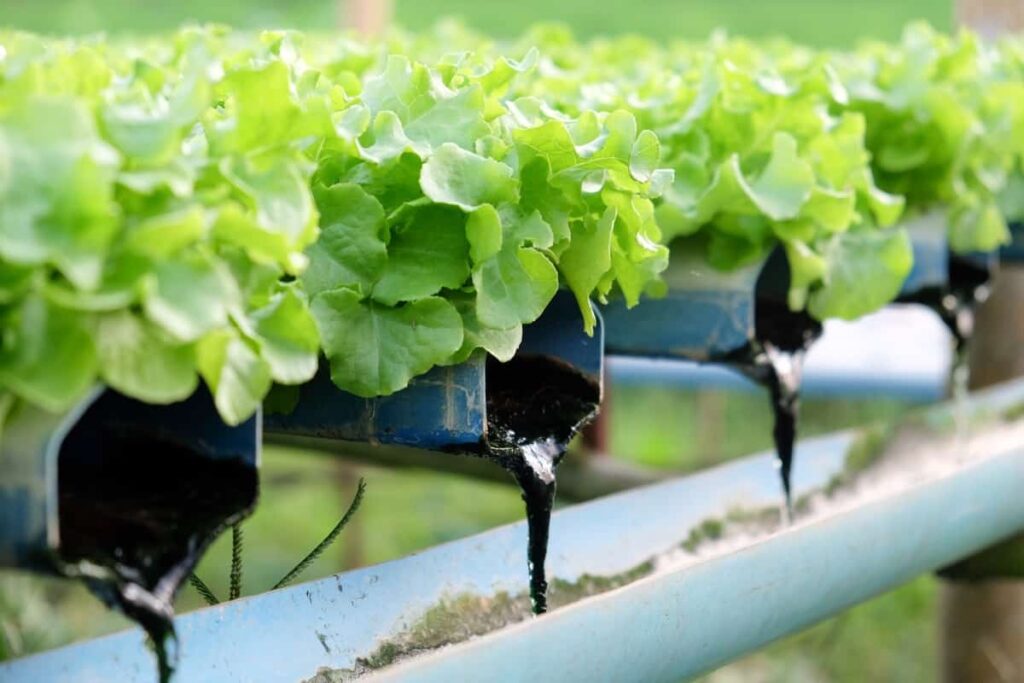
In DWC, seedlings are transplanted onto Styrofoam rafts floating on a pond of nutrient solution. Water circulation and aeration are achieved through pumps and oxygen injection. On the other hand, NFT involves transplanting seedlings onto shallow channels where a thin film of nutrient solution flows continuously. DWC offers the advantage of maintaining stable water temperature, pH, electrical conductivity (EC), and nutrient solution composition due to the large water volume used.
Maintaining Proper Humidity Levels for Hydroponic Leafy Green Vegetables
- Optimal humidity range: Leafy greens thrive in relative humidity (RH) levels between 50% and 70%. This range ensures adequate moisture for plant growth while minimizing the risk of fungal diseases.
- Humidity and transpiration: Higher humidity reduces the transpiration rate, preventing excessive water loss from plant leaves. This helps maintain proper hydration and prevents wilting.
- Disease prevention: High humidity above 70% can create a favorable environment for diseases like powdery mildew and botrytis. To avoid these issues, it’s important to maintain humidity within the optimal range.
- Ventilation and dehumidification: Proper ventilation and air circulation within the growing area help regulate humidity levels. Additionally, using dehumidifiers can effectively reduce humidity in enclosed hydroponic systems.
Essential Nutrients for Healthy Growth of Leafy Green Vegetables in Hydroponics
- Nitrogen (N): Maintain a concentration of 150 ppm in the nutrient solution.
- Phosphorus (P): Keep the phosphorus level at 31 ppm.
- Potassium (K): Provide a concentration of 210 ppm of potassium.
- Calcium (Ca): Maintain a calcium concentration of 90 ppm.
- Magnesium (Mg): Provide 24 ppm of magnesium.
- Sulfur (S): Keep the sulfur level at 32 ppm.
- Iron (Fe): Maintain an iron concentration of 1.0 ppm.
- Manganese (Mn): Provide 0.25 ppm of manganese.
- Zinc (Zn): Keep the zinc level at 0.13 ppm.
- Boron (B): Provide 0.16 ppm of boron.
- Copper (Cu): Maintain a copper concentration of 0.023 ppm.
- Molybdenum (Mo): Provide 0.024 ppm of molybdenum.
Pest and Disease Management in Hydroponic Leafy Green Vegetable Gardens
To maintain plant health and maximize yields, pest, and disease management is crucial in hydroponic leafy green vegetable gardens. Five common diseases that affect hydroponic crops are Pythium root rot, powdery mildew, Botrytis blight, basil downy mildew, and Sclerotinia blight. Identify the symptoms is the first step in early detection.
In case you missed it: How to Grow Hydroponic Vegetables Indoors: Key Rules, Methods, and Tips
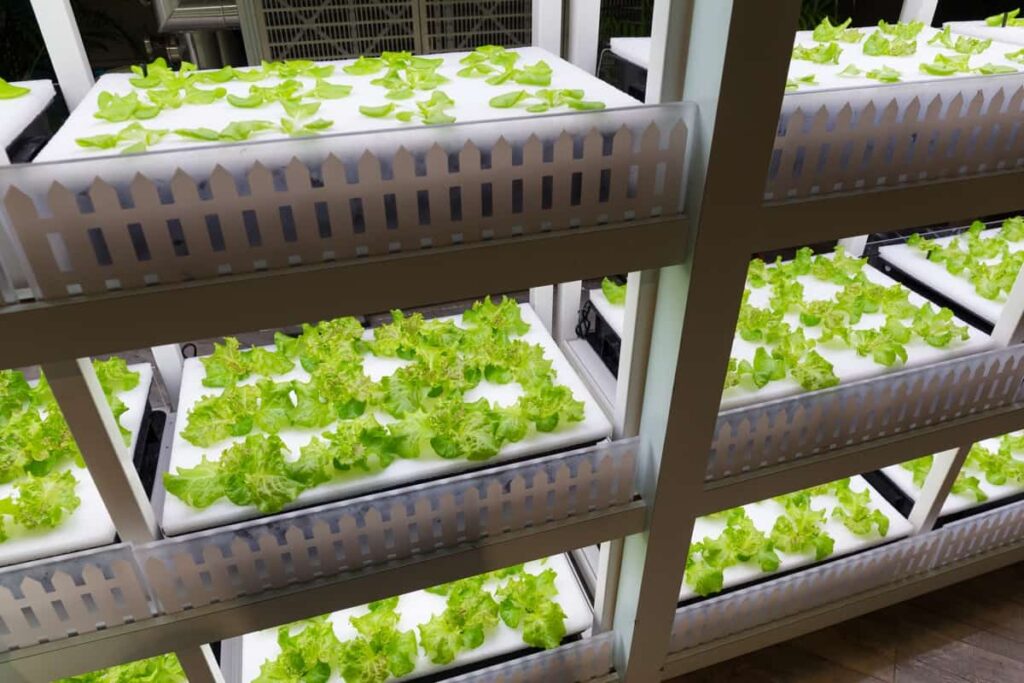
Cultural management practices are significant in disease prevention, such as maintaining proper nutrient balance, optimizing environmental conditions, and practicing good hygiene. Preventive measures like implementing fungicide controls can help minimize the risk of disease outbreaks. By implementing effective pest and disease management practices, hydroponic growers can ensure the health and productivity of their leafy green vegetable gardens.
Harvesting and Storing Hydroponically Grown Leafy Green Vegetables
Harvesting and storing hydroponically grown leafy green vegetables require careful attention to ensure the product maintains its quality and freshness. Harvesting should be done when the vegetables have reached their desired size and maturity. Scientific studies have shown that harvesting leafy greens in the morning when temperatures are low helps preserve their flavor and nutritional value. Using clean, sharp tools to minimize plant damage during harvest is important.
After harvesting, the vegetables should be washed gently to remove debris or soil particles. Proper storage is crucial to maintain the freshness of the leafy greens. Leafy greens can be stored in perforated plastic bags or containers in the refrigerator. Studies suggest that storing leafy greens at temperatures around 0-4°C (32-39°F) with a relative humidity of 95% helps extend their shelf life. However, consuming the harvested produce within a few days is important to ensure optimal flavor and nutritional content.
Conclusion
Growing leafy green vegetables in hydroponics provides year-round production and controlled environments. Hydroponic growers can successfully produce high-quality, flavorful, and nutritious leafy greens for local markets and consumers by choosing the right system, maintaining optimal conditions, and managing nutrients. Some of the leafy greens to grow in Hydroponics are mentioned in the below table.
| Lettuce | Li Ren Choi |
| Spinach | Miz America Mustard |
| Malabar Spinach | Mizuna |
| Indian Sorrel | Curly Kale |
| Roselle | Portuguese Kale |
| Amaranth | Red Cloud |
| Asian Delight | Red Komatsuna |
| Astro Arugula | Red Veined Sorrel |
| Black Magic Kale | Rosie |
| Carlton | Swiss Chard |
| Green Giant Mustard | Tatsoi |
| Green Sorrel | Tokyo Bekana |
| Bok choy/Chinese cabbage |
- Sheep Farming Business Plan for Beginners
- Aquaponic Farming at Home: A Step-By-Step Guide
- Profitable Village Farming Business Ideas in 2024
- High-Yield Aquaculture: Fast-Growing Fish for Farming
- Effective Fish Pond Construction Techniques for Beginners
- Irrigation and Water Management in Pineapple Farming
- Blossom to Harvest: Mastering Flowering and Pollination in Papaya Farming
- Pig Fattening Essentials: From Selection to Sale for Beginners
- Raising Wagyu Cattle: A Complete Guide for Premium Beef Production
- Soil Types and Their Water Holding Capacity
- Optimizing Irrigation Schedules for Coconut Groves for Enhanced Yield
- Espresso Your Garden: Coffee Grounds for Healthier Acid-Loving Plants
- The Best Soil Mix for Snake Plants: How to Mix Your Own Snake Plant Soil
- Green Thumb Success: Expert Tips for Cultivating Greenhouse Beans All Year Round
- Bloom All Year Round: The Ultimate Guide to Indoor Hyacinth Care
- Eco-Friendly Gardening: How to Make Liquid Fertilizer from Kitchen Waste
- Ultimate Guide to Grow Anise in Pots: Explore Seed Propagation to Harvesting
- Guide to Raising Chester White Pigs: Discover Breed Facts to Growth Management
- Mastering the Elegance: The Ultimate Guide to Weeping Cherry Tree Care, Planting, and Maintenance
- Ultimate Guide to Planting Garlic in Grow Bags: Growing Strategies for Beginners
- How to Fix Spider Plant Leaf-Related Problems: Natural and Organic Remedies
- 10 Reasons Why Your Tulsi Plant is Shedding Leaves: Home Remedies and Solutions
- Optimizing Growth and Yield: The Advantages of Palm Bunch Ash Fertilizer
- Utilizing Neem Oil Extract as a Natural Pesticide for Hydrangea
- From Soil to Harvest: Various Ways in Which Farmers Can Use AI Tools
- Steps to Encourage and Induce Citrus Flowers: A Comprehensive Guide
- How to Fix Snake Plant Leaf-Related Issues: Natural and Organic Remedies
- Transform Your Garden into a Fragrant Oasis with Raat Ki Rani (Night Blooming Jasmine)
- Discover the Ideal Chicken Breeds for Philippine Farms
- How to Create a Poultry Egg Farm Business Plan for Profits
- Grow Lemon Cucumbers Like a Pro: Insider Techniques for Bountiful Yields
- Ultimate Guide to Caring for Your Pink Princess Philodendron: Tips for Thriving Variegation
- Areca Nut Profit Per Acre: Calculating Yield and Cost of Cultivation
- How Kaveri Chicken is Becoming a More Profitable Breed in Indian Backyards
- Transform Your Barn: 9 Steps to Convert a Horse Stall into a Chicken Coop
- Exploring Suffolk Sheep Disadvantages with Limitations and Challenges

Any centre for training near Bangalore